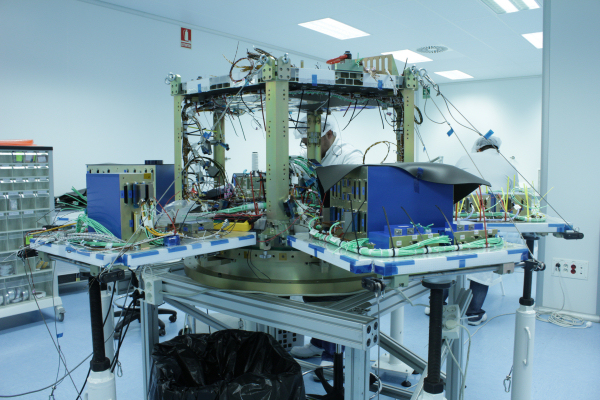#4: Delivery of the Instrument Engineering Model
3 May 2016
The CHEOPS spacecraft continues its fast-track implementation with the delivery of the instrument Engineering Model for integration on the satellite Electrical and Functional Model. |
| CHEOPS flight platform during harness integration. Credit: ADS–Spain |
The engineering model of the CHEOPS payload, also known as the instrument Engineering Model (EM), was delivered to the spacecraft prime contractor (EADS CASA Espacio) in Madrid, on Thursday 7 April. Since then, it has been integrated with the platform Engineering Functional Model (EFM) to perform satellite-level electrical and software tests. This marks another milestone in the satellite's development.
The instrument EM is composed of three engineering model units: the Focal Plane Module simulator, the Sensor Electronic Module, and the Back-End Electronics. In addition, this instrument EM is equipped with a first release of the flight software.
 |
 |
| Elements of the CHEOPS instrument Engineering Model. Credit: ADS–Spain | |
The tests that have been carried out allow engineers to validate the electrical and software interfaces between platform and instrument.
The instrument EM was controlled for the first time through the platform on-board computer, verifying the execution of telecommands sent by the platform and the correct reception of telemetry data. The tests are due to be completed by early May.
In parallel to reaching this key instrument milestone, CHEOPS also achieved another two important test results: completion of the first System Validation Test (SVT) and of the Radio Frequency Compatibility Test (RFCT).
On 15 and 16 February, the first CHEOPS SVT was performed: the platform EFM, located at the premises of EADS CASA Espacio, was successfully controlled using the mission control system installed at the headquarters of GMV, in Madrid. GMV is the prime contractor for the development phase of the Mission Operations Centre (MOC) and is responsible for the development of a number of CHEOPS operation tools.
The MOC will be operated by the Instituto Nacional de Técnica Aeroespacial (INTA) from their site in Torrejon de Ardoz, Spain. This is also the location of the primary ground station antenna (TRN-1) that will be used during nominal operations. Interfaces between TRN-1 and a test model of the satellite transceiver were verified at the INTA site during the week beginning Monday 29 February 2016.
The Radio Frequency Compatibility Test will be repeated at the European Space Operations Centre (ESOC), in Darmstadt, Germany, to prove compatibility of CHEOPS with the ESA ground stations, and in particular with the antenna in Kiruna, Sweden, which will be used during the early operational phase.
Progress continues on the platform. The platform Structural and Qualification Model has been refurbished into the flight structure, and integration of the cable harness completed. Thermal control hardware is being progressively installed, and the integration of the flight equipment is due to start in early June. The integration of the platform flight model is expected to be completed during the summer, with tests starting in September 2016.
About CHEOPS
CHEOPS is an ESA mission implemented in partnership with Switzerland, through the Swiss Space Office (SSO). The University of Bern leads a consortium of 11 ESA Member States contributing to the mission and represented in the CHEOPS Science Team. ESA is the mission architect, responsible for overall mission definition and procurement of the spacecraft and launch. ESA is also responsible for the early operations phase that will be carried out by the spacecraft contractor, EADS CASA Espacio S.L., which is part of Airbus Defence and Space. The science instrument is led by the University of Bern, with important contributions from Austria, Belgium, Germany and Italy. Other contributions to the science instrument, in the form of hardware or science operations, are provided by Hungary and by France, Portugal, Sweden and the United Kingdom respectively. Following successful in-orbit commissioning of the spacecraft, responsibility for operations will be taken over by the CHEOPS Mission Consortium, with the Mission Operations Centre under the responsibility of Spain and the Science Operations Centre led by and located at the University of Geneva, Switzerland.



